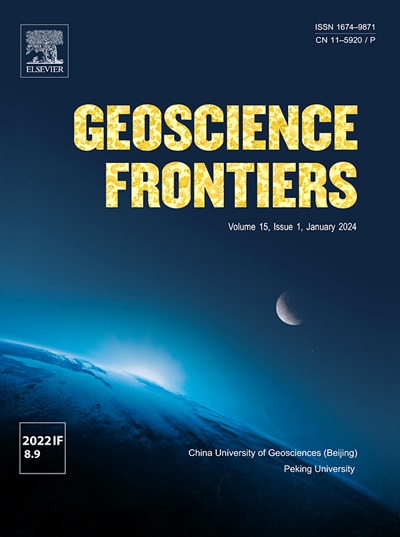Predicting groundwater fluoride levels for drinking suitability using machine learning approaches with traditional and fuzzy logic models-based health risk assessment
IF 8.9
1区 地球科学
Q1 GEOSCIENCES, MULTIDISCIPLINARY
引用次数: 0
Abstract
The primary objective of this study is to measure fluoride levels in groundwater samples using machine learning approaches alongside traditional and fuzzy logic models based health risk assessment in the hard rock Arjunanadi River basin, South India. Fluoride levels in the study area vary between 0.1 and 3.10 mg/L, with 32 samples exceeding the World Health Organization (WHO) standard of 1.5 mg/L. Hydrogeochemical analyses (Durov and Gibbs) clearly show that the overall water chemistry is primarily influenced by simple dissolution, mixing, and rock-water interactions, indicating that geogenic sources are the predominant contributors to fluoride in the study area. Around 446.5 km2 is considered at risk. In predictive analysis, five Machine Learning (ML) models were used, with the AdaBoost model performing better than the other models, achieving 96% accuracy and 4% error rate. The Traditional Health Risk Assessment (THRA) results indicate that 65% of samples pose highly susceptible for dental fluorosis, while 12% of samples pose highly susceptible for skeletal fluorosis in young age groups. The Fuzzy Inference System (FIS) model effectively manages ambiguity and linguistic factors, which are crucial when addressing health risks linked to groundwater fluoride contamination. In this model, input variables include fluoride concentration, individual age, and ingestion rate, while output variables consist of dental caries risk, dental fluorosis, and skeletal fluorosis. The overall results indicate that increased ingestion rates and prolonged exposure to contaminated water make adults and the elderly people vulnerable to dental and skeletal fluorosis, along with very young and young age groups. This study is an essential resource for local authorities, healthcare officials, and communities, aiding in the mitigation of health risks associated with groundwater contamination and enhancing quality of life through improved water management and health risk assessment, aligning with Sustainable Development Goals (SDGs) 3 and 6, thereby contributing to a cleaner and healthier society.

基于传统和模糊逻辑模型的健康风险评估的机器学习方法预测地下水氟化物水平的饮用适宜性
本研究的主要目的是利用机器学习方法以及基于传统和模糊逻辑模型的健康风险评估,在印度南部Arjunanadi河硬岩流域测量地下水样本中的氟化物水平。研究区域的氟化物含量在0.1至3.10毫克/升之间,有32个样本超过了世界卫生组织(WHO) 1.5毫克/升的标准。水文地球化学分析(Durov和Gibbs)清楚地表明,整体水化学主要受简单溶解、混合和岩石-水相互作用的影响,表明地质来源是研究区域氟化物的主要来源。大约446.5平方公里被认为处于危险之中。在预测分析中,使用了5个机器学习(ML)模型,其中AdaBoost模型表现优于其他模型,准确率达到96%,错误率为4%。传统健康风险评估(THRA)结果表明,65%的样本对氟牙症高度敏感,而12%的样本对年轻年龄组氟骨症高度敏感。模糊推理系统(FIS)模型有效地管理歧义和语言因素,这些因素在解决与地下水氟化物污染相关的健康风险时至关重要。在该模型中,输入变量包括氟化物浓度、个体年龄和摄入率,输出变量包括龋齿风险、氟牙症和氟骨症。总体结果表明,摄取率的增加和长期接触受污染的水,使成年人和老年人以及非常年幼和年轻的年龄组容易患牙齿和骨骼氟中毒。本研究是地方当局、卫生保健官员和社区的重要资源,有助于减轻与地下水污染相关的健康风险,并通过改进水管理和健康风险评估来提高生活质量,符合可持续发展目标3和6,从而为更清洁、更健康的社会做出贡献。
本文章由计算机程序翻译,如有差异,请以英文原文为准。
求助全文
约1分钟内获得全文
求助全文
来源期刊

Geoscience frontiers
Earth and Planetary Sciences-General Earth and Planetary Sciences
CiteScore
17.80
自引率
3.40%
发文量
147
审稿时长
35 days
期刊介绍:
Geoscience Frontiers (GSF) is the Journal of China University of Geosciences (Beijing) and Peking University. It publishes peer-reviewed research articles and reviews in interdisciplinary fields of Earth and Planetary Sciences. GSF covers various research areas including petrology and geochemistry, lithospheric architecture and mantle dynamics, global tectonics, economic geology and fuel exploration, geophysics, stratigraphy and paleontology, environmental and engineering geology, astrogeology, and the nexus of resources-energy-emissions-climate under Sustainable Development Goals. The journal aims to bridge innovative, provocative, and challenging concepts and models in these fields, providing insights on correlations and evolution.
 求助内容:
求助内容: 应助结果提醒方式:
应助结果提醒方式:


